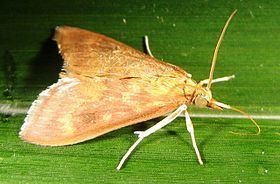Kingdom Animalia Class Insecta Family Crambidae Rank Species | Phylum Arthropoda Order Lepidoptera Subfamily Pyraustinae | |
Similar Ostrinia, European corn borer, Sesamia inferens, Atherigona, Crambidae | ||
Ostrinia furnacalis is a species of moth in the family Crambidae, the grass moths. It is known by the common name Asian corn borer. Its distribution extends from China to Australia. It is well known as an agricultural pest on several crops, especially corn. It is one of the worst corn pests in Japan and China. It has invaded corn crops in Guam and the Northern Mariana Islands. It can be found in Java, Sulawesi, the Philippines, Borneo, New Guinea, the Solomon Islands, and Micronesia. It is likely the worst pest insect on corn in the western Pacific region of Asia, and one of the worst pests overall, second only to maize downy mildew. This moth is a close relative of the European corn borer (O. nubilalis).
Contents

Biology
This is apparently a species complex; other Ostrinia such as O. orientalis, O. scapulalis, O. zealis and O. zaguliaevi can occur with O. furnacalis, and the taxa can be hard to tell apart.
The adult Asian corn borer is a moth with a wingspan of about 3.5 centimeters and yellow-brown with brownish lines. It lays a mass of about 25 to 50 eggs on plant leaves. The egg is half a millimeter long and white in color, turning black before emergence. The first-instar larva is pinkish with dark spots and a dark head. The late-instar larva is yellow-brown with dark spots and reaches up to 2.9 centimeters long.
The species sometimes has a skewed sex ratio; many female moths produce mostly female offspring. Some broods are entirely female. This thelygeny is probably caused by a bacterial infection that feminizes the male offspring. This is supported by evidence that antibiotic application produces all-male offspring broods. This is not unheard of; in other taxa such as wasps and various crustaceans, infection with Wolbachia can skew sex ratios.
During courtship, the male produces an ultrasound call by rubbing scales on its wings against scales on its thorax. The female responds to this signal by becoming motionless. This makes it easier for the male to mate. In another form of mating-related communication, the female produces sex pheromones.
In agriculture
This insect can cause devastating losses in a corn field. In the Philippines losses of 20 to 80% have been reported. In Taiwan it has reached 95%, and in the Marianas, 100%. The moth larva feeds on almost any part of the plant, damaging the fruit when it bores into the ear to feed on the silk and kernels. It also invades the tassels, where it feeds on pollen; detasseling the corn can help to reduce larval populations.
The moth will take advantage of a number of host plants other than corn, including other crops such as bell pepper, cotton, hops, millet, pearl millet, foxtail millet, sugarcane, sorghum, and ginger. It can be found on a number of wild plants, as well, such as wormwoods, Job's-tears, knotweeds, wild sugarcane, Johnson grass, and para grass.
Control
One method used to control the moth in Asia is the wasp Trichogramma ostriniae, a native parasitoid of the moth's eggs. This method of biological pest control has shown some success. Trichogramma dendrolimi has also been used. Trichogramma chilonalis has been used in Guam, but is less effective. Trichogramma evanescens has been released in the Philippines. The earwig Euborellia annulata is also used for biocontrol. Some bacteria that inhabit the gut of entomopathogenic nematodes, specifically Xenorhabdus and Photorhabdus spp, have the pathogenic potential to kill Ostrinia furnacalis within 48 hours.
Like the European corn borer, this moth is susceptible to Bt corn, a crop which has been genetically modified to produce Bt toxin. This corn has been introduced to the Philippines, where it has been monitored to gather data on its relationship with the moth. It has been successful, producing higher yields than conventional corn breeds. Bt cotton has had some success in China. Another method of controlling the pest in cotton crops is to intercrop with corn, growing some corn plants in the cotton field. The moth overwinters in corn plants, and providing some of these helps to relieve the cotton plants of their moth loads. Bt-based pesticides are available, and conventional chemical pesticides are used. Corn breeding is continuing in the search for varieties resistant to the moth.
Natural enemies of the moth include several parasites such as the tachinid fly Lydella grisescens, the braconid wasp Macrocentrus cingulum, and the ichneumon wasp Eriborus terebrans. It is also susceptible to the entomopathogenic fungi Beauveria bassiana and Nosema furnacalis. It may develop the insect disease muscardine.
